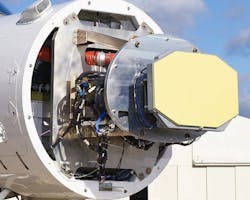Air Force orders more advanced F-16 jet fighter SABR AESA radar avionics systems from Northrop Grumman
WRIGHT-PATTERSON AFB, Ohio – U.S. Air Force aerial warfare experts are ordering additional modern active electronically scanned array (AESA) radar for F-16 jet fighter aircraft under terms of an $88.2 million order announced Friday.
Officials of the Air Force Life Cycle Management Center, Fighter Bomber Directorate, F-16 Division, at Wright Patterson Air Force Base, Ohio, are asking the Northrop Grumman Corp. Mission Systems segment in Linthicum Heights, Md., for 31 production radars and spare parts.
The APG-83 AESA fire-control scalable agile-beam radar (SABR) integrates within the F-16’s structural, power, and cooling constraints without Group A aircraft modification, Northrop Grumman officials say. The company leverages technology developed for the APG-77 and APG-81 radar systems on the U.S. F-22 and F-35 combat aircraft.
In a 2013 competition, Lockheed Martin Corp., the F-16 manufacturer, selected the APG-83 as the AESA radar avionics for the F-16 modernization and update programs of the U.S. Air Force and Taiwan air force.
The bandwidth, speed, and agility of AESA radars enable legacy fighter aircraft like the F-16 to detect, track, and identify many targets quickly and at long ranges, and to operate in hostile electronic warfare (EW) environments.
Northrop Grumman is building APG-83 radar systems for global F-16 upgrades and new aircraft production, as well as for the U.S. Air National Guard. Northrop Grumman also has installed a production APG-83 SABR on a U.S. Marine Corps F/A-18C Hornet jet fighter-bomber, company officials say.
On this order Northrop Grumman will do the work in Linthicum Heights, Md., and should be finished by July 2025. For more information contact Northrop Grumman Mission Systems online at www.northropgrumman.com, or the Air Force Life Cycle Management Center at www.aflcmc.af.mil.

John Keller | Editor-in-Chief
John Keller is the Editor-in-Chief, Military & Aerospace Electronics Magazine--provides extensive coverage and analysis of enabling electronics and optoelectronic technologies in military, space and commercial aviation applications. John has been a member of the Military & Aerospace Electronics staff since 1989 and chief editor since 1995.

